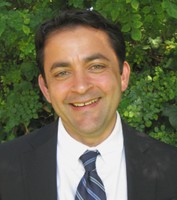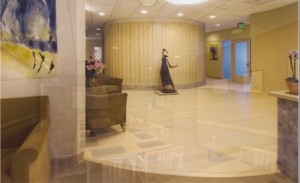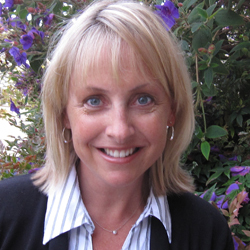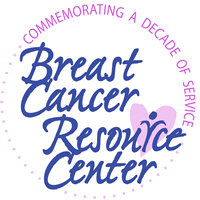As Director of the County Education Office’s Center for Community Education, Ben Romo oversees a variety of different programs designed to serve the needs of foster children, homeless youth, low income students and children that have been neglected for a variety of reasons. He also works closely with the business community as the Executive Director of Partners in Education, a nonprofit organization working to help children succeed in school and in the workforce.
Leslie Dinaberg: How did you go from politics (as the District Representative and Primary Political Consultant for Congressman Walter Capps and Congresswoman Lois Capps) to education?
Ben Romo: In 2005 I had reached a point in my business where I wasn’t really learning anymore… and I realized that the only way I could continue learning was to go to a much higher level like statewide and multiple congressional campaigns, and that would have been just an absolute life-consuming process.
When this opportunity came to be a part of the education office, it was something that was very appealing to me personally, in terms of the work that we do here at the center, but also was appealing to me intellectually. Plus, it brought me back to Santa Barbara where I was born and raised.
LD: Are you enjoying this work?
BR: It’s been eye opening, what I’ve come to learn about public education and particularly the areas of impoverished, neglected and delinquent youth. It’s been really eye opening. I thought I knew a lot about public education and I didn’t. I didn’t know exactly what schools are being forced to deal with and I didn’t fully understand the level of misperception that I think exists in the community about just how daunting those challenges are and how unfair it is for society to expect schools to meet those needs.
LD: It’s very challenging and in our community particularly, because there’s so much wealth, it’s really the haves and have-nots.
BR: We’re losing our middle class. We’re a community out of balance. … Since 1991, our student population went from 34% Hispanics, it’s now 57%; Anglos were 55%, they’re now 32%. There’s just a complete flip-flop. Almost one in five, 17% of children in Santa Barbara County live below the federal poverty line, and the federal poverty level is $19,000 for a family of four. So that’s a federal measurement that has a completely different reality on the ground here in Santa Barbara where $900 a month might get you a one-bedroom or studio apartment.
LD: I know that Computers for Families works on this issue by targeting the digital divide and providing computers and Internet at home for every student in the fourth grade. What else does Partners in Education do?
BR: Partners is a nonprofit. We are not a school, we are not in the business of doing what schools should already be doing themselves, we’re not about supplanting, we are about finding the right role that the community can play to be supportive of schools. But schools are charged with a particular set of things that they should be doing. We’re not here to take that burden off them. That should be their responsibility. We are here to support them, number one, and also to give business a voice in how schools are preparing the next generation of the workforce.
LD: But a lot of the things that should be the school’s responsibility, like for example technology, they just don’t have the dollars to back it up. It’s not that the will isn’t there, but there isn’t the money.
BR: Exactly. We just talked about this in our last board meeting, we’re very clear that we are not going to be in a position to go find all that money. We found a very cost effective way to meet some of the needs that low income kids have in accessing the Internet and technology and we found that that’s really significantly impactful in their ability to achieve academically and in the school’s ability to achieve system wide. …
I don’t think it’s really been clearly stated to educators and the broader community just what technology can bring in key areas that teachers are worried about, student achievement, parent involvement, student engagement in the classroom, and the saving of teacher’s time, which is a huge issue for educators.
LD: In my experience it still comes down to the level of an individual teacher’s engagement and comfort with technology. If they’re into it, they’ll use it and their kids will really benefit from it and if they’re not, it’s not a factor.
BR: And who can blame them when they’re so stressed and so focused on core curriculum areas? It’s difficult for a teacher to take any time away from a student who is below grade level in math and English.
LD: What do you think are some of the biggest challenges that we have in education?
BR: Schools are doing a really good job actually. If you look at student achievement system wide in the state of California, student achievement in every group has gone up. In English learners, in Latinos, in Anglos, in every group, student achievement in math and reading has gone up. The achievement gap is being addressed, but there are societal problems that are being thrust on schools and schools are being forced to deal with these. And I think, in some cases, in a lot of cases, they are unfairly held accountable or they are unfairly expected to do a job that they were never intended to do and that is being a social worker. Teachers are supposed to teach kids how to read and write and how to be good citizens. So I think the biggest challenge in public education are the challenges that society thrusts upon them unfairly.
LD: Switching gears now from society to you, if you could pick three adjectives to describe yourself, what would they be?
BR: Modest, good looking and visionary
LD: That’s the best answer I’ve had to that question–and the fastest.
(Laughter overheard from the office next door): Irritating, annoying, deluded …
BR: (Laughs) OK, I like to have fun, I try to be honest, and sometimes I’m insecure.
Vital Stats: Ben Romo
Born: At Goleta Valley Hospital; August 21, 1973
Family: Wife Geordie and daughter Ruby, 4-1/2 months
Civic Involvement: The Granada, Coastal Housing Coalition, CALM, Nonprofit Support Center, Student Aid Committee of the Santa Barbara Foundation
Professional Accomplishments: Founded Romo & Associates; District Representative and Primary Political Consultant for Walter and Lois Capps
Little-Known Fact: When Ben was a child his nickname was Benny Big Ears; he also went by Benjie the Dog.
Want to know more about Partners in Education?
A breakfast event, featuring State Superintendent of Public Instruction Jack O’Connell, will be held December 7, 2007 at Earl Warren Showgrounds from 7:15-9:00 a.m. If you would like to attend, please RSVP to Ben Romo by emailing benromo@sbceo.org or calling 964.4711 ext 4401.









